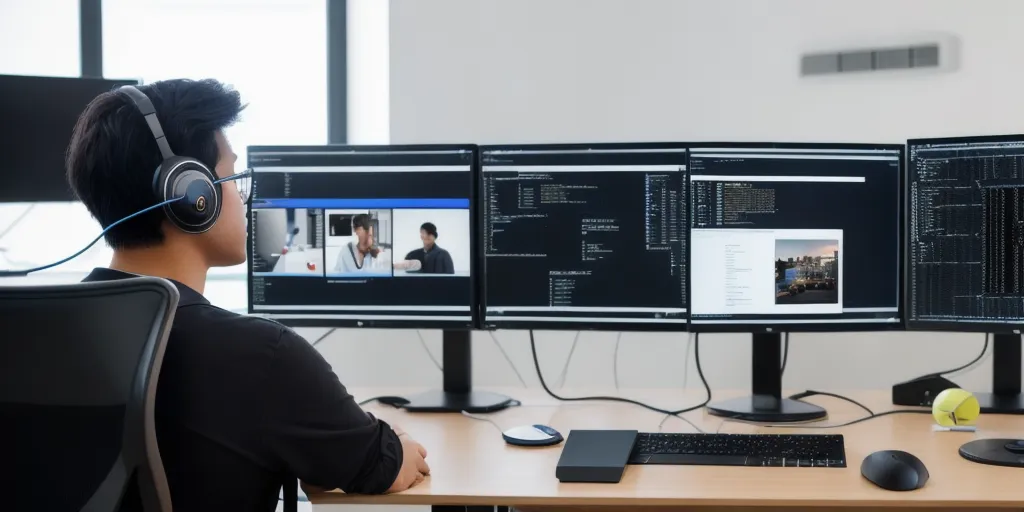To easily use AI to make fake videos realistic, one can utilize deep learning algorithms and neural networks to generate convincing visual content. By training AI models on large datasets of real videos, the technology can learn to mimic human movements, facial expressions, and speech patterns.
This process, known as deepfake technology, allows users to seamlessly superimpose faces onto different bodies or manipulate existing footage to create entirely new scenarios.
To achieve realistic results, it is essential to have high-quality source material and access to advanced AI software such as deep learning frameworks like TensorFlow or PyTorch. Additionally, understanding the ethical implications of creating fake videos is crucial, as misuse of this technology can lead to misinformation and harm.
By following best practices and using AI responsibly, one can harness the power of artificial intelligence to produce convincing fake videos that are indistinguishable from reality. Ultimately, the key to creating realistic fake videos lies in leveraging AI technology effectively and ethically to achieve desired outcomes.
What technologies can enhance fake video realism?

Technologies that can enhance fake video realism include deep learning algorithms, computer graphics, and artificial intelligence. Deep learning algorithms, such as Generative Adversarial Networks (GANs), can be used to create realistic facial expressions, movements, and backgrounds in fake videos.
These algorithms analyze and learn from large datasets of real videos to generate convincing fake content. Computer graphics software, like Adobe After Effects or Blender, can be used to add visual effects, manipulate footage, and enhance the overall realism of fake videos.
These tools allow creators to seamlessly blend real and fake elements to create a more convincing final product. Artificial intelligence can also play a role in enhancing fake video realism by automating the process of generating and editing content.
AI-powered tools can assist in tasks such as face swapping, voice synthesis, and scene reconstruction, making it easier for creators to produce high-quality fake videos. By leveraging these technologies, creators can push the boundaries of video manipulation and create increasingly realistic fake content.
How can ai mimic human movements in videos?

Artificial Intelligence (AI) can mimic human movements in videos through a process known as pose estimation. This technology uses algorithms to analyze video footage frame by frame, identifying key points on a person’s body such as joints and limbs.
By tracking the movement of these key points over time, AI can accurately recreate the motion of a human in a video. Additionally, AI can be trained using machine learning techniques to recognize patterns in human movement and generate realistic animations. This training process involves feeding the AI large amounts of data, such as videos of people performing various actions, so that it can learn to replicate these movements.
Furthermore, AI can also utilize deep learning models, such as convolutional neural networks, to enhance its ability to mimic human movements with greater precision and detail.
Overall, AI’s ability to mimic human movements in videos is a result of its advanced algorithms, machine learning capabilities, and deep learning models, which enable it to analyze and replicate complex movements with remarkable accuracy.
What are the ethical considerations in creating fake videos?

Ethical considerations in creating fake videos are numerous and significant. Firstly, the act of creating fake videos raises concerns about truth and deception. By manipulating footage to create a false narrative, creators of fake videos are essentially spreading misinformation and distorting reality.
This can have serious consequences, such as misleading the public, damaging reputations, and even inciting violence or unrest. Additionally, creating fake videos can violate the privacy and rights of individuals who are depicted in the footage without their consent.
This raises ethical questions about consent, respect, and the potential harm that can be caused by exploiting someone’s image or likeness. Furthermore, fake videos can also be used for malicious purposes, such as spreading propaganda, manipulating public opinion, or perpetuating harmful stereotypes.
In essence, the ethical considerations in creating fake videos revolve around issues of truth, deception, consent, privacy, and the potential harm that can result from spreading misinformation. It is crucial for creators to consider these ethical implications and strive to uphold integrity, honesty, and respect in their work.
Which ai frameworks are best for generating realistic videos?

When it comes to generating realistic videos using AI frameworks, there are several options that stand out for their capabilities. One of the most popular choices is Deepfake technology, which uses deep learning algorithms to create highly realistic videos by swapping faces or altering facial expressions.
Another powerful AI framework for generating realistic videos is NVIDIA’s StyleGAN, which can generate high-quality images and videos with impressive realism. Additionally, OpenAI’s DALL-E and CLIP models have shown promise in creating visually stunning and realistic content by combining text and images.
These frameworks leverage advanced machine learning techniques to produce videos that are indistinguishable from real footage. Furthermore, Google’s DeepDream and DeepMind’s WaveNet are also noteworthy AI frameworks that can be used to generate realistic videos with unique visual effects and audio enhancements.
Overall, the best AI frameworks for generating realistic videos are those that combine cutting-edge technology with sophisticated algorithms to produce high-quality and lifelike content.